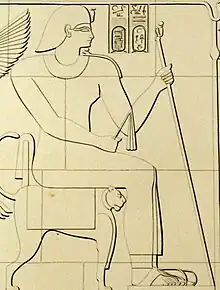| Amanislo | ||||||||||||||||||||||||||||||||||||||||||||||||||
|---|---|---|---|---|---|---|---|---|---|---|---|---|---|---|---|---|---|---|---|---|---|---|---|---|---|---|---|---|---|---|---|---|---|---|---|---|---|---|---|---|---|---|---|---|---|---|---|---|---|---|
 Amanislo as depicted in his tomb (Beg. S 5) | ||||||||||||||||||||||||||||||||||||||||||||||||||
| Pharaoh | ||||||||||||||||||||||||||||||||||||||||||||||||||
| Reign | Middle 3rd century BCE | |||||||||||||||||||||||||||||||||||||||||||||||||
| Predecessor | Arakamani | |||||||||||||||||||||||||||||||||||||||||||||||||
| Successor | Amantekha | |||||||||||||||||||||||||||||||||||||||||||||||||
| ||||||||||||||||||||||||||||||||||||||||||||||||||
| Burial | Meroe, Beg. S 5 | |||||||||||||||||||||||||||||||||||||||||||||||||
Amanislo was a king of Kush dating to the middle of the third century BCE.[1]
Monuments and inscriptions

Pyramid of King Amanislo, Meroë Southern Cemetery
Amanislo is mainly known from his pyramid at Meroë. He is buried in Meroe, Beg. S 5. From the position of his pyramid it has been argued that he was the successor of king Arakamani and the predecessor of Amantekha.[1][2]
He is also known from an inscription on a granite lion figure, originally belonged to the Egyptian pharaoh Amenhotep III and now at the British Museum. There is also a column drum, found at Semna perhaps providing his name, although the reading is uncertain.
In modern culture
Amanislo appears as Amonasro, King of Ethiopia in Verdi's Aida, following the scenario written by Auguste Mariette.
References
Literature
- Laszlo Török, in: Fontes Historiae Nubiorum, Vol. II, Bergen 1996, p. 568-569, ISBN 82-91626-01-4
This article is issued from Wikipedia. The text is licensed under Creative Commons - Attribution - Sharealike. Additional terms may apply for the media files.
